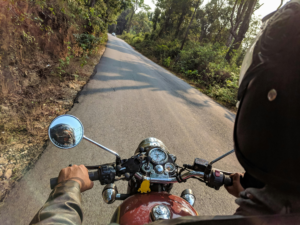 Ask any motorcyclist, and they will tell you that a bike provides an unparalleled thrill and sense of freedom. However, with that joy comes inherently more significant risks, notably a higher likelihood of injury. Skinner Lawyers is here to help readers understand how to prevent a motorcycle accident and how to navigate a claim if injured in a motorcycle accident.
Ask any motorcyclist, and they will tell you that a bike provides an unparalleled thrill and sense of freedom. However, with that joy comes inherently more significant risks, notably a higher likelihood of injury. Skinner Lawyers is here to help readers understand how to prevent a motorcycle accident and how to navigate a claim if injured in a motorcycle accident.
The Facts
Statistics show that motorcyclists experience significantly higher rates of accidents and fatalities compared to car drivers. According to the National Highway Traffic Safety Administration (NHTSA), motorcyclists accounted for 14% of all traffic fatalities in 2022, with 6,218 motorcyclists killed—the highest number since 1975.
Safety is vital for all motorcyclists with more riders and vehicles on the road. Riders should focus on safety gear, defensive riding, and getting comprehensive insurance to cut motorcycle injury rates. Recognizing the dangers and adopting preventive actions, such as following helmet regulations and practicing road safety, is vital for all motorcyclists.
Loud Pipes Save Lives: How to Ride Safely
As more and more people turn to motorcycles as their primary mode of transportation or for recreational purposes, it’s important to recognize the potential dangers of riding a motorcycle.
Here are a few recommendations from the Skinner team that can help motorcyclists protect themselves on the road:
Protective Gear: Proper protective gear significantly reduces injury severity in accidents and is a crucial aspect of motorcycle safety. A well-fitted helmet, compliant with helmet laws, jackets, gloves, pants, and boots, can protect against road rash, abrasions, and head injuries. Despite the sobering statistics, many riders fail to invest in adequate safety gear, increasing their risk of motorcycle injury.
Pre-Ride Inspection: Before hitting the road, conducting a thorough pre-ride inspection is essential for road safety. Checking vital components like tires, brakes, lights, and fluid levels ensures the motorcycle is in optimal condition. Regular maintenance, like oil changes and brake checks, boosts performance, extends longevity, and helps prevent accidents.
Protect Your Head: Helmets that meet or exceed safety standards are crucial for preventing head injuries and are a fundamental aspect of safe riding. Properly fitting helmets are vital for optimal safety and can significantly reduce the severity of motorcycle injuries in the event of an accident.
Riding Techniques: Defensive riding is crucial for ensuring road safety, as it involves anticipating and navigating potential hazards. Riders should focus on maintaining a safe distance from other vehicles, vigilantly scanning for obstacles, and refining their braking and cornering skills to enhance safety. Use hand signals and make eye contact with drivers to ensure they know your presence on the road.
Mindful Riding: Drivers of larger vehicles frequently claim not to see motorcyclists on the road, so riders must always remain acutely aware of their surroundings and other drivers’ actions. Concentration and focus are paramount while riding. Distractions like texting and fatigue can impair judgment and reaction times, increasing the risk of accidents. Staying alert, well-rested, and hydrated enhances safety on the road. Taking breaks throughout long rides can help preserve focus and improve safety.
Riding in Different Conditions: Adverse weather and urban environments present unique challenges for riders. Safe navigation through rain, wind, heavy traffic, and complex intersections requires proper gear and cautious riding.
Group Riding Safety: Riding in a group requires coordination and communication among riders. Establishing riding formations, maintaining safe distances, and adapting to changing road conditions ensure a smooth and secure ride for everyone. Riding in groups can also benefit, providing more excellent safety in numbers.
Dealing with Emergencies: Despite precautions, emergencies may arise. Knowing basic roadside repairs, administering first aid, and carrying emergency tools and contacts can mitigate risks and ensure timely assistance. These measures and comprehensive motorcycle insurance can provide peace of mind during unforeseen events. Additionally, being informed about accident reconstruction can be beneficial in understanding and learning from accidents to improve safety practices.
A vital component of motorcycle accident safety is securing comprehensive insurance coverage. In the unfortunate event of an accident, having insurance can protect you financially and help cover medical or repair costs. It is essential to thoroughly research and compare insurance policies to find one that best suits your riding needs.
Accidents can still happen even when all precautions have been taken. However, knowing how to handle a crash can significantly reduce the risk of serious injuries.
In a motorcyclist and another vehicle wreck, the first and most important focus should be securing safety and immediate medical attention. First, evaluate the situation and the rider’s condition. Once you’ve called 911 for emergency services, contacting an attorney, such as Skinner Accident & Injury Lawyers, is crucial. Legal professionals can provide essential guidance through the aftermath of the accident.
Mastering motorcycle safety is a continuous journey requiring dedication and vigilance. Prioritize safety gear, practice defensive riding, understand helmet laws, invest in motorcycle insurance, and stay alert to minimize risks. Acknowledging the possibility of motorcycle accidents, riding responsibly, and taking preventive measures are crucial to ensure a safer riding experience.
For more insights, explore additional resources on motorcycle accidents. Safety always comes first—ride smart, ride safe, and enjoy the open road responsibly.

